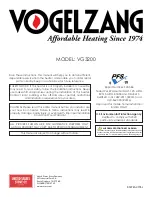
CLEO COMBI
.
8192000 Rev.08 – EN
27
•
in particular, initially it is possible to note the emission or typical odours of metals that have undergone great heat
stress and of fresh paint. This paint, even if fired at 250°C in the construction phase for a few hour s, must exceed
temperatures of 350°C several times in a certain du ration of time, before being perfectly incorporated with the
metal surfaces.
It is therefore important to follow these small arrangements in the lighting phase:
1)
Make sure that a strong air change is guaranteed in the place where the appliance is installed.
2)
The first times lighting is performed, do not feed the combustion chamber excessively (about half the amount
indicated in the instruction manual) and keep the product lit for about 6-10 hours continuously, with the registers
less open than that indicated in the instruction manual.
3)
Repeat this operation for at least 4-5 times, according to your availability.
4)
Successively, increase feeding (following that described in the instruction manual relative to the maximum feed)
and keep lighting periods long avoiding, short switch-on/off cycles at least in this initial phase.
5) During the first lightings, no object should be placed on the appliance, especially on the lacquered
surfaces. The lacquered surfaces must not be touched during heating.
6)
Once «running in» has been past, the product can be used like a car motor, avoiding sudden overheating with
excessive loads.
9.1.
WOOD IGNITION
IMPORTANT: The burner cap (CB chap.) must be cleaned every time the product is lit
as described in the
chapter 14.5.
1) Open the lateral access hatch to the mechanical parts (
L
Picture 8); if the lever (
C
) is already in position
L-W-H
(LEGNA-WOOD-HOLZ) go to point 3);
2) With the use of the poker in the position
D
, lift the latch
and decontrol the lever (
C
) push it toward the
rear side
of
the stoves in the position marked with the letters L-W-H;
push it several times so that the latch (
D
) stops in the next
tooth at the end of the same latch (Pos.
1
Figure 1); cast
iron grate (
G
) in the lifted position;
3) check that the hatch of the pellet feeding tank (
S
) is closed
and locked using the handle (
B
);
4) close the lateral access door (
L
) to the mechanical parts.
ATTENTION: before lighting the stove, it must be in its
original state, i.e. with the lateral door
(
L
)
closed and the tank lid
(
S
)
closed via the
relevant handle
(
B
)
.
To light the fire, we recommend the use of small wooden slats
with newspaper or other lighting means on the market,
EXCLUDING all liquid substances e.g. alcohol, benzene,
petrol and similar
.
PROHIBITED.
The air register must be completely open, therefore turned
completely to the right (
R
Picture 1).
When the wood starts to burn, other fuel can be fed, close the
air register (turn to the left) to control combustion according to
the indications in the paragraph 10.
Never leave the stove unattended during this phase
.
Never overfeed the stove
(consult the technical table – max. quantity of fuel that can be fed).
Too much fuel and too much air for combustion can cause overheating and therefore damage the stove
.
9.2.
PELLET IGNITION
IMPORTANT: The burner must be cleaned every time the product is lit
as described in the chapter 14.5.
Before lighting the stove, the following points must be verified:
•
the feed-box must be full of pellets (see chapter 12)
•
the combustion chamber must be clean
•
the burner (
B
) must be completely free and clean (see chapter 14.5)
Picture 8
B
C
D
L-W-H
L
S
G
1
















































